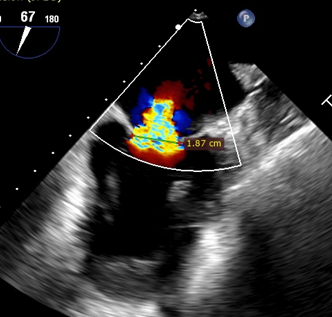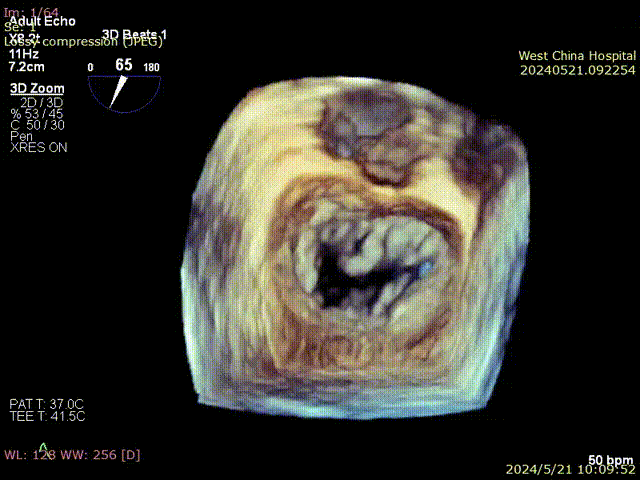Remarkable achievement! Professor Chen Mao's team at West China Hospital successfully treats a 97-year-old patient with mitral regurgitation using #TEER, setting a new record for the highest age #TEER in China
Professor Chen Mao's team at West China Hospital, Sichuan University, successfully treated a 97-year-old patient with mitral regurgitation using transcatheter edge-to-edge repair (TEER), setting a new record for the highest age of TEER surgery in China.


Patient History:
The patient, a 97-year-old male, was admitted due to "3 months of fatigue and shortness of breath after activity, worsening for 15 days." Three years prior, he had undergone pacemaker implantation for atrioventricular block. Upon admission, echocardiography revealed severe mitral regurgitation.
Preoperative transesophageal echocardiography assessment:

Preoperative regurgitation
Transesophageal echocardiography revealed severe atrial fibrillation mitral regurgitation (AFMR 4+), with mitral annular dilation leading to severe regurgitation. The regurgitant width was 19mm, predominantly originating from the A2/P2 region, with anterior leaflet length measuring 26mm and posterior leaflet length measuring 14mm. The valve orifice area was 5.12cm², with a mean transvalvular pressure gradient of 1mmHg. Pulmonary vein reflux was significant.


Preoperative X-plane assessment of regurgitation in the A2/P2 region


Preoperative 3D view

Preoperative valve orifice area:5.12cm²

Preoperative transvalvular pressure gradient:1mmHg
For a 97-year-old patient with mitral regurgitation, traditional open-heart surgery is merely theoretically possible. However, pharmacological treatment alone is ineffective for such patients, with severe heart failure symptoms persisting. Therefore, minimally invasive TEER surgery may be the optimal choice.
Challenges and Difficulties of the Surgery:
Challenge 1: The patient's regurgitant width is 19mm, and there is significant mitral annular dilation. If a single clip cannot reduce the regurgitation to mild or below, additional clips may be required, further increasing the difficulty of the surgical procedure.
Challenge 2: For elderly patients, organ function degradation makes them less tolerant of prolonged surgeries and the potential complications associated with them. Close collaboration among the entire cardiac team is necessary to ensure zero errors while swiftly completing the surgery. This places higher demands on the anesthesiologist, nursing team, echocardiographer, and surgeon alike.
Preoperative Strategy:
Prior to the surgery, Professor Chen Mao's team extensively discussed the case. Considering the wide regurgitation, significant mitral annular dilation, and low transvalvular pressure gradient, they decided to initially use one MitraClip G4 XT to clip the A2/P2 region. Subsequently, they would assess the situation to determine whether to proceed with implanting a second clip.
Surgical Procedure:
After the patient was under general anesthesia and draped, a right femoral vein access was established. Under transesophageal echocardiography guidance, precise puncture of the interatrial septum was performed. The puncture depth was 3.9cm. Subsequently, the steerable guide catheter (SGC) and the first XT clip delivery system were advanced into the left atrium. In the A2 region, the clip arms were adjusted to point towards the 12 o'clock to 6 o'clock position, accurately capturing and successfully grasping the anterior and posterior leaflets at the site of most severe regurgitation, followed by closure.

3D Localization




Clipping Process

Postoperative tissue bridge
After implanting one MitraClip G4 XT, there was a significant improvement in mitral regurgitation, with the regurgitant volume decreasing from severe to trace. The average transvalvular pressure gradient reduced to 2mmHg, and there was no longer pulmonary vein reflux. The length of leaflet grasp for both anterior and posterior leaflets exceeded 9mm. Following the release of the valve clip, stability was achieved, and the surgery concluded perfectly.

Postoperative transvalvular pressure gradient 2mmHg


Postoperative Assessment
Postoperative Summary:
Transcatheter edge-to-edge repair (TEER) surgery is a minimally invasive intervention technique used to treat mitral regurgitation (MR). In cases of atrial fibrillation mitral regurgitation (AFMR), especially when the regurgitant orifice is wide, TEER procedures often present significant challenges. Special techniques may be necessary, requiring highly individualized surgical plans and close collaboration among multidisciplinary teams. For such patients, detailed preoperative assessments, precise intraoperative imaging guidance, personalized surgical strategies, and comprehensive postoperative management are all key factors for success.

发表留言
暂无留言
输入您的留言参与专家互动